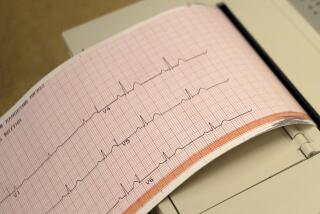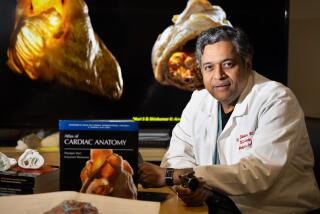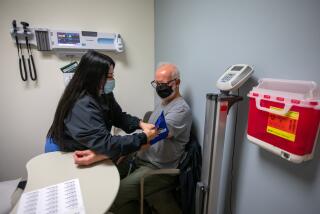Effective Artificial Heart Seems Within Reach
HERSHEY, Pa. — Building an artificial heart seemed so easy in the 1960s: design a pump, implant the contraption in a patient’s chest and hook it up to the arteries.
How naive medical researchers were in that era of moon shots.
Building an artificial heart means designing a pump that beats 100,000 times every 24 hours with neither lubrication nor maintenance, that pumps faster when the body is exercising and slower when the body is sleeping, that causes neither infection nor clots, that has a constant power source. That, they quickly learned, is a very different matter.
Today’s researchers are close to the elusive goal they have pursued since the Kennedy administration: a permanent, fully implantable replacement for the heart.
Surgeons can now hook patients to assist pumps for a few months, or even years, until transplants become available or until their hearts recover. Many of them go home with batteries and monitors to wait.
Within a few years, researchers say, patients should be able to leave the hospital for good with some sort of device pumping their blood.
Many will go home with the next generation of assist pumps, or LVADs, left ventricular assist devices, attached to their diseased hearts. Today’s LVADs are temporary, requiring vents and cords poking out of patients’ skin, but the new pumps will be smaller and entirely implantable and should last five years or more.
Patients with more serious heart disease will probably need total artificial hearts instead. The artificial heart--medicine’s Holy Grail for four decades--replaces the natural organ.
This time, when researchers say a few years, they mean it.
“I can show you talks people have given over the years, and they all say ‘Five years away. Five years away.’ That was back in the ‘60s,” said Dr. William Pierce, semiretired director of Penn State’s artificial organ program.
“When we say three years now, we have durability tests. We have animals who’ve survived for more than a year. Those estimates are real,” he said.
The reason: This generation of pumps is vastly improved. The biomaterials that come in contact with blood are safer. The components are smaller. And designers know more about how the body reacts to a pump made of titanium, velour and plastic.
“It’s a very, very long road, and it’s very complicated,” said Dr. Robert Jarvik, one of the field’s best-known pioneers. “There’s vastly more knowledge than when we started.”
Houston’s Texas Heart Institute and Danvers, Mass.-based Abiomed Inc. appear to be first in the race to a total artificial heart. They plan to test a “replacement heart” in humans at the end of 2000.
The other contender, Penn State, is about three years from testing its artificial heart in humans.
But the university is also part of a larger race to make the assist pumps work indefinitely. Penn State’s totally implantable assist pump, built with Arrow International Inc. of Reading, Pa., was used for the first time in October in a 67-year-old patient in Germany. That patient is doing well, the pump was implanted in a second patient recently and more are planned in the coming months.
Among the others nearing the testing phase:
* Dr. Robert Jarvik, who designed the first pump intended for permanent use and says his latest assist pump will be tested on humans for the first time this month in England.
* Dr. Michael DeBakey, the famous heart surgeon, with Houston’s MicroMed Technology Inc. and NASA;
* Thermo Cardiosystems Inc., maker of today’s most widely implanted assist pump, HeartMate.
Thousands could benefit. About 40,000 people suffer from end-stage congestive heart failure, meaning their hearts do not pump strongly enough. The best therapy is a transplant, but the number of donor hearts has leveled off at 2,000 a year. Many patients do not qualify for transplants because of their age or weight.
Officially, the number of patients waiting for donor hearts totaled 4,285 in October, according to the United Network for Organ Sharing. In 1998, 769 patients died before a heart became available.
Proponents of the artificial heart say it will not only help those waiting for hearts, but could also benefit hundreds of thousands of patients with clogged arteries.
Almost 40 years after the artificial heart programs were launched in the can-do ‘60s, 15 years after the pumps flopped spectacularly in the 1980s, researchers’ optimism is palpable.
But it is tempered by the decades of dashed expectations.
Dr. O.H. Frazier of the Texas Heart Institute recalls the boundless enthusiasm of his mentor, Dr. William Hall, one of the pioneers of the artificial heart program.
Frazier remembers Hall telling him that by 1980 there would be 100,000 Americans with artificial hearts.
“I thought, ‘Well, that’s great. We’ll have solved heart disease by the time I’m 40, and then I can cure cancer before I die,’ ” Frazier remembered. “Tragically, Dr. Hall died a few years ago of heart failure, and we’re still waiting for this technology.”
Along the way, surgeons have found powerful new tools to treat heart disease.
None is more important than the LVAD, developed in the shadow of the total artificial heart. Some researchers are betting that LVADs --with a few improvements over current designs--could do the job of their more celebrated cousin.
For now, the U.S. Food and Drug Administration has approved LVADs to keep patients alive for transplants.
Most LVADs sit in the abdomen and take over most of the work of the left ventricle, which pumps blood to the body. Weakening of the left ventricle is the cause of most cases of congestive heart failure.
The most widely used is HeartMate. The 5-pound pump is attached to the heart by tubes. A vent and cords jut out of the stomach. One cord runs to a regular wall outlet or battery. The others are connected to devices that control and monitor the pump as it swishes and clicks like a milking machine.
Baxter Novacor and Thoratec Laboratories Corp., both California companies, also sell implantable VADs.
More than 4,000 patients have used them--so many that the procedure is almost routine for surgeons like Frazier.
On one recent afternoon, he reflected on the technology during a break from the operating room. Due back minutes later to remove a pump from a patient, he told a story of an LVAD patient from 10 years ago.
“When we put the pump in I was massaging his heart all the way to the O.R. until I could get him down there,” Frazier said. “He got a transplant, eventually went home, and that’s the last time he’s been in the hospital, actually. So it’s a remarkable technology.”
A scientific study of the benefits of the LVAD, conducted from 1986 to 1994, showed that 33% of recipients of HeartMate died within 60 days, but of the rest, nine out of 10 were still alive a year later.
Another group of patients met the criteria to get HeartMate, but because Waltham, Mass.-based Thermo Cardiosystems was a small company, not enough pumps were available. Only one-third of the patients were still alive 60 days after getting a new heart.
“So you took patients that would have died, and you gave them a 60% chance of living,” Frazier said. “Certainly, every one of these patients I see that I supported, I know I’m in a sense looking at a ghost.”
Chuck McKissick feels that way.
McKissick, of Norwich, N.Y., had a heart attack at 38 and another one at 43. Six months after the second one, McKissick was in terrible shape. He slept all day and couldn’t walk across his mobile home without stopping for a breath. His heart pumped 1.4 liters per minute, 20% of normal.
He got a HeartMate in May.
“I feel 100% better, oh, god yes,” he said from an apartment near Penn State’s Hershey Medical Center, where he awaits a transplant.
He can walk around the apartment, cook dinner, walk out on the patio. Plugged into the batteries, he’s free for hours. He can leave the apartment, take a walk, go shopping.
With each patient who uses an LVAD temporarily, the artificial heart designers learn more about how to turn them into permanent alternatives to transplants.
Thermo Cardiosystems, with help from the National Institutes of Health, is conducting a randomized study of HeartMate in 140 patients at 20 sites. Some patients get the LVAD, the others medicine and other treatment. If all goes as planned, the company hopes to ask the FDA to approve HeartMate as an alternative to transplant.
“That’s our goal,” said Michael Klein, chief executive officer of Thermo Cardiosystems. “We have competition with a lot of the other folks out there, but we have a tremendous amount of experience.”
The competition--Thermo Cardiosystems, too--is looking to improve on HeartMate.
The LVADs they are testing have none of the cords and are much smaller. Some look unlike anything in a human. Several groups are pinning their hopes on a turbine the size of a C battery that looks and works like a jet engine; the natural heart can be a backup in case of a pump failure.
MicroMed, Thermo Cardiosystems and New York-based Jarvik Heart Inc. all have continuous flow pumps in testing.
“We won’t be able to make it in the exact configuration of a natural heart, but we’ve never been able to make a bird either. We still fly,” Frazier said.
Abiomed and Penn State, meanwhile, proceed separately on total artificial hearts that closely resemble nature’s work: pumps that beat out an unrelenting rhythm.
Both are implantable, with neither vents nor electrical cords going through the skin. The concept is a vastly improved version of the Jarvik-7 and Penn State hearts implanted in the 1980s.
For many patients, the total artificial heart may be necessary even if LVADs succeed as permanent devices. Thousands of patients couldn’t be treated with an assist pump, including those with problems on both sides of the heart and those who suffered massive heart attacks.
That medicine is on the verge of a replacement heart--again--is a stunning recovery for a field that once damaged itself by cultivating too much media attention.
In 1982 William DeVries shocked the world, and some of his colleagues, when he implanted the ill-fated Jarvik-7 into a patient named Barney Clark.
The world saw disturbing images of a sick Clark tethered to a console of electronics. Four others would get the Jarvik in the next two years. Only one lived beyond a year. Most in the field acknowledge now that the Jarvik was too experimental to meet the public’s expectations.
But the race was on.
“We felt a little bold,” said Dr. Bartley Griffith, a surgeon at the University of Pittsburgh Medical Center, who implanted more than 20 Jarvik-7s. “I was younger, full of vim and vigor. Hadn’t had all the tragedies, those things that happen to you as you get older.”
Griffith gave his first Jarvik to Thomas Gaidosh, 47, and the operation was a milestone. After four days on the device, he got his donor heart and became the first patient to leave the hospital after a Jarvik operation. He lived 11 more years, long enough to be best man at Jarvik’s wedding.
DeVries’ attempt to turn the Jarvik into a permanent treatment failed, partly because William Schroeder’s 620-day ordeal--he had four strokes and a constant fever--turned the public against the procedure. But the scientists building the next generation of devices learned too much to consider those early tests mistakes.
There were medical insights about clotting and infection. They learned that they need to treat the implantation like a regular, scheduled surgery, using fresh, rested surgeons and otherwise healthy patients rather than rushing dying people into the O.R.
“We learned these devices were not like religious agents. They couldn’t resurrect someone who was too far down,” Griffith said.
And they learned how public opinion can turn a medical advance into a debacle.
Age has tempered their arrogance and experience has made them wiser, but their ambitions remain the same. And this next foray into artificial hearts will be different, they promise.
“I’m very excited,” said David Lederman, Abiomed’s chief executive. “But I don’t want to exaggerate where we are. I think if we do that, we will make the same mistakes that were made before, and we will turn something that is very exciting into a catastrophe.”






